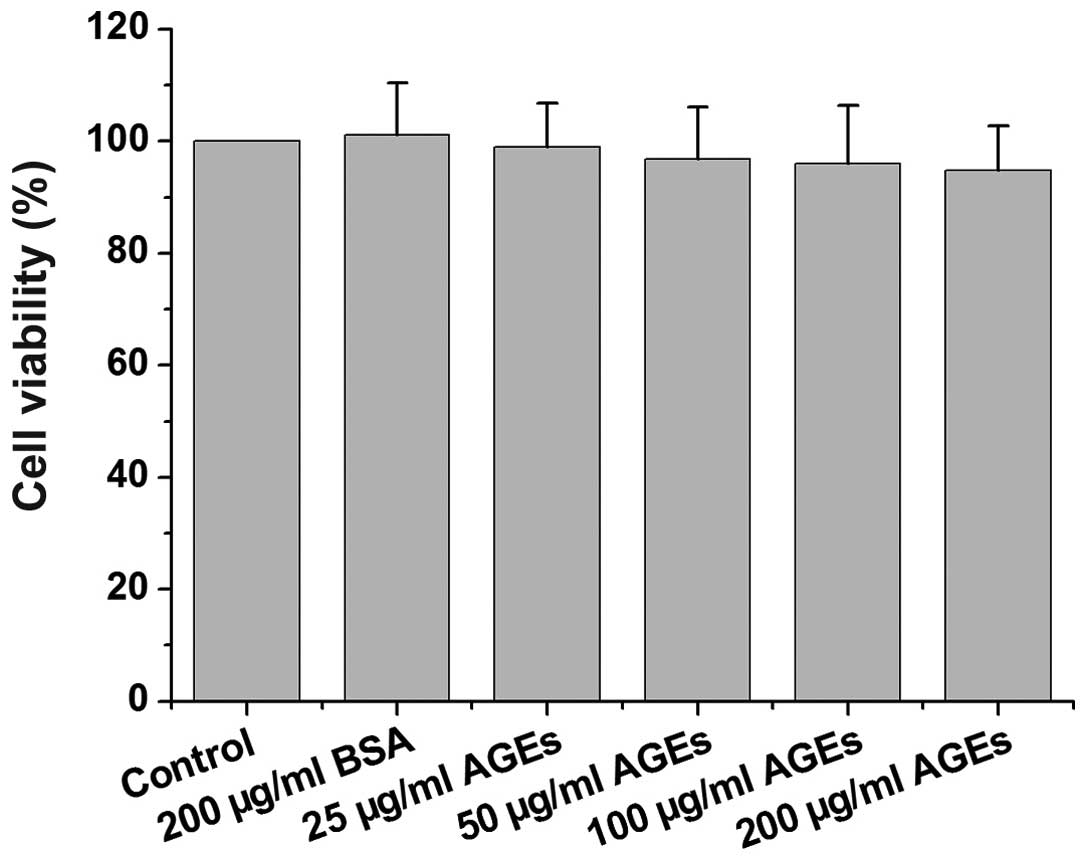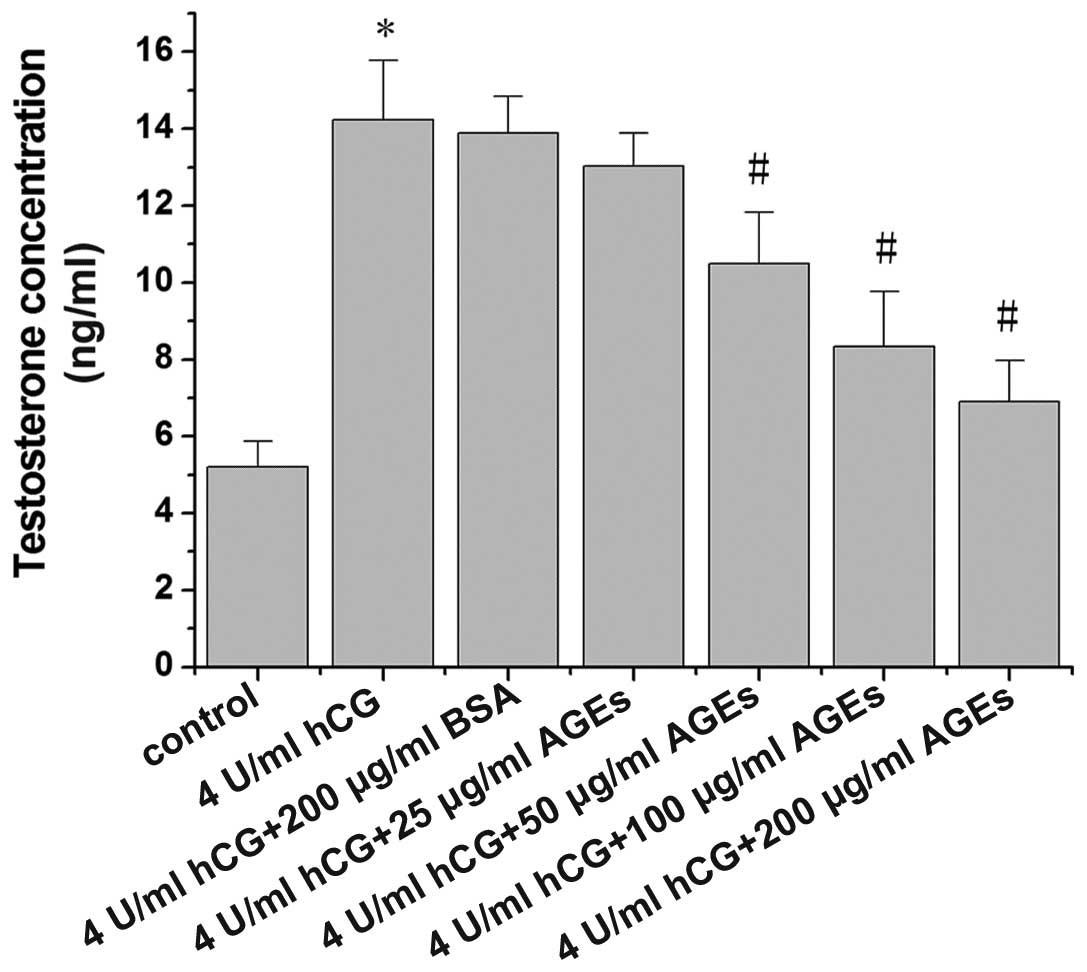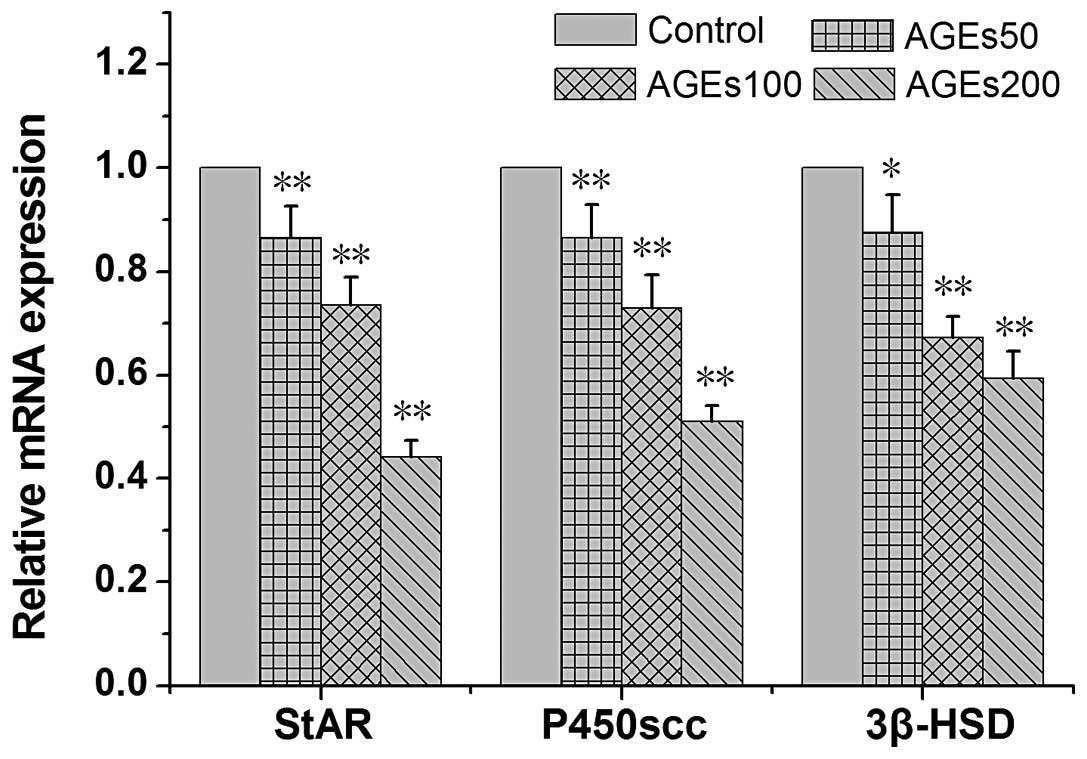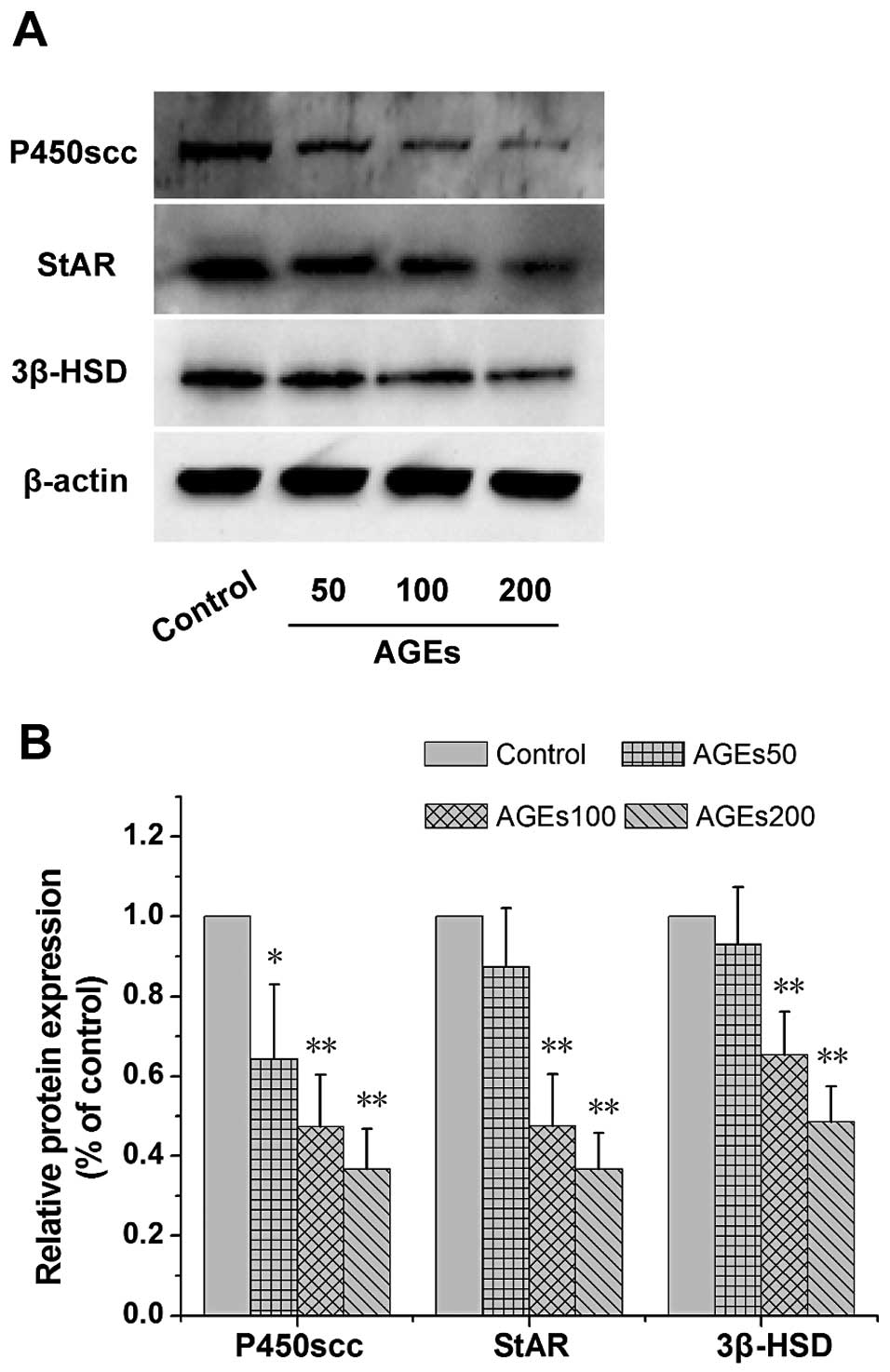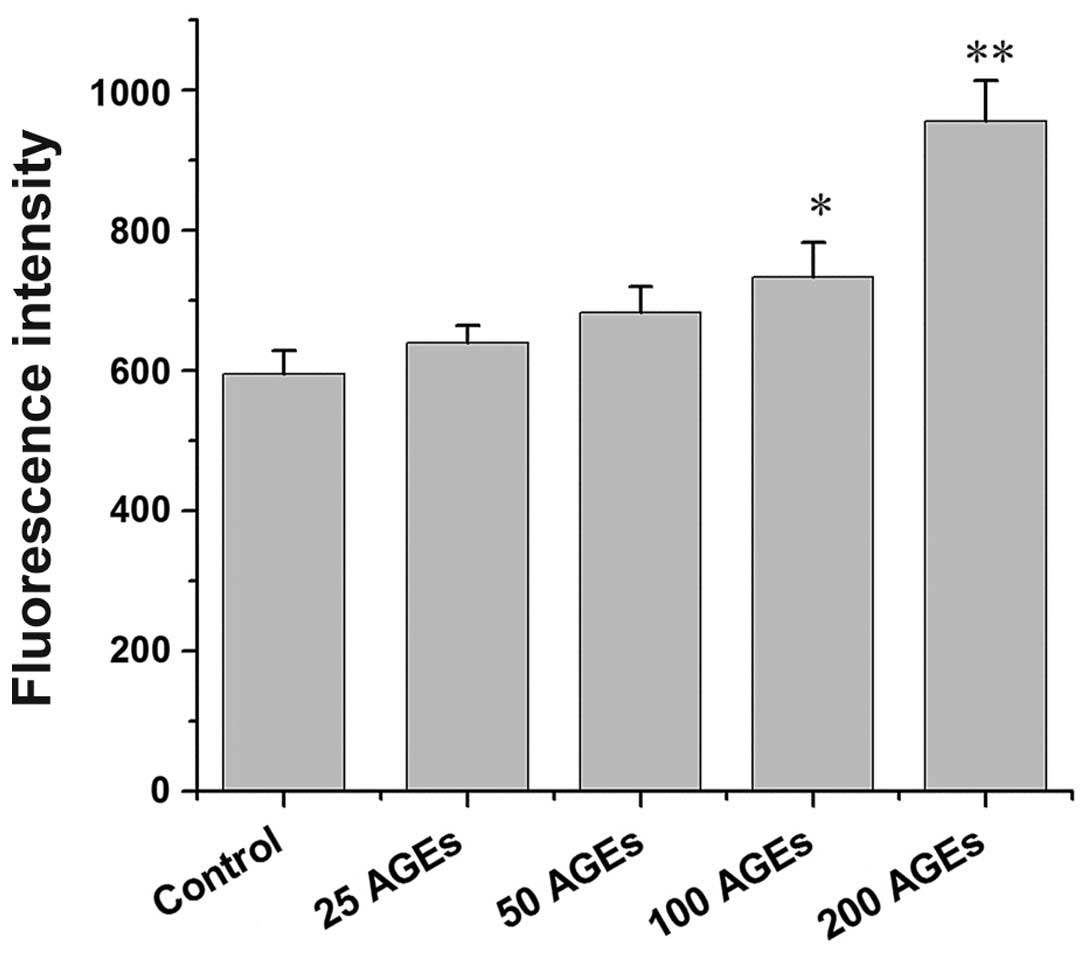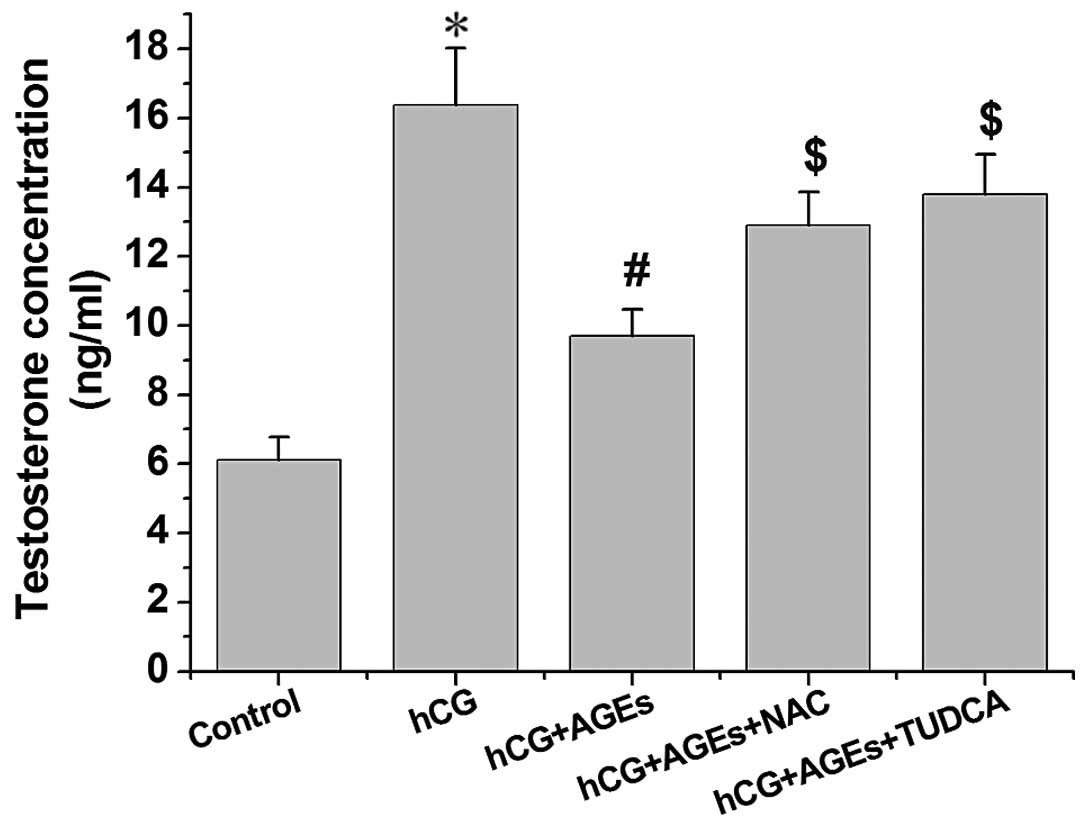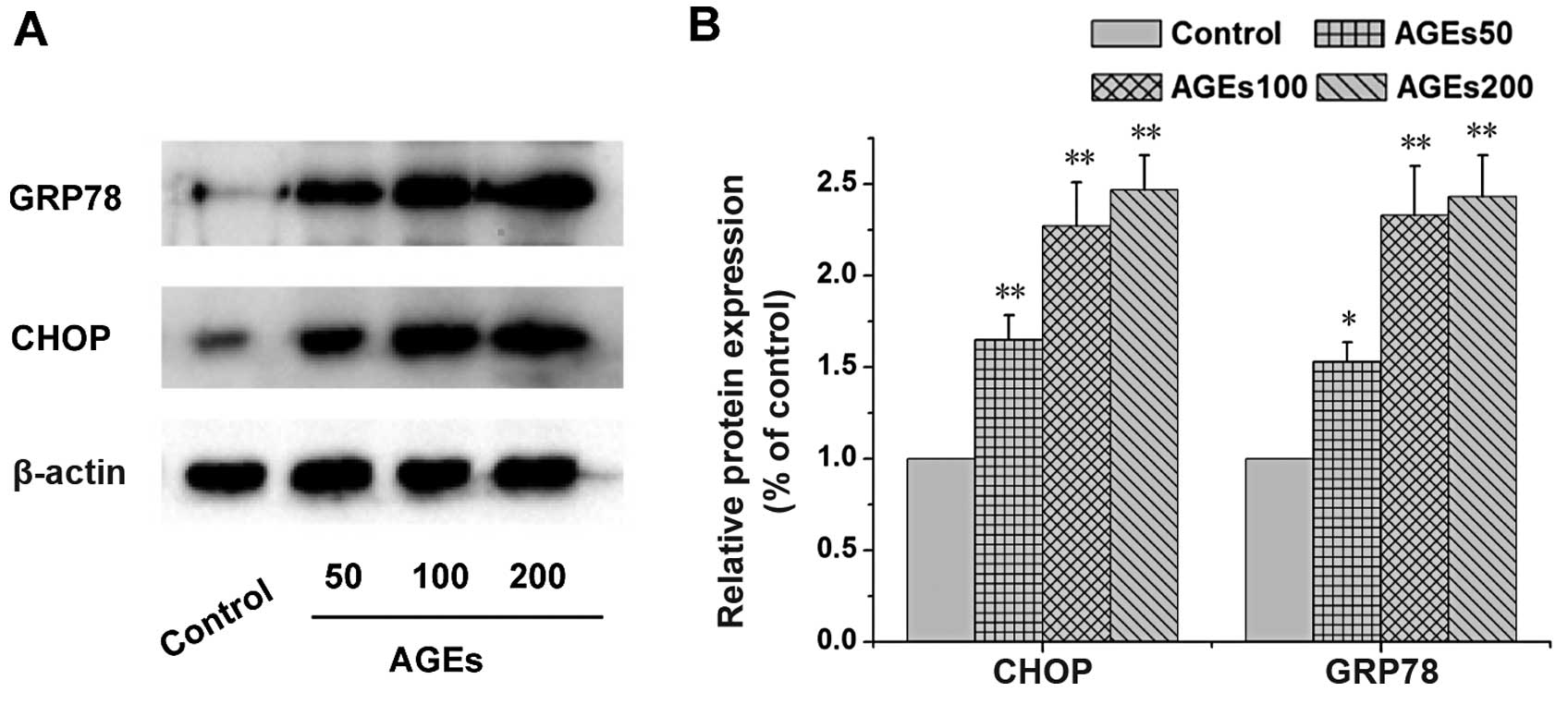Advanced glycation end products inhibit testosterone secretion by rat Leydig cells by inducing oxidative stress and endoplasmic reticulum stress
- Authors:
- Published online on: June 16, 2016 https://doi.org/10.3892/ijmm.2016.2645
- Pages: 659-665
Abstract
Introduction
According to the Diabetes Atlas of the International Diabetes Federation, 382 million individuals were affected by diabetes worldwide in 2013 and its prevalence is expected to increase to 592 million by the year 2035 (1). With the increasing prevalence of diabetes in children and adolescents, male reproductive dysfunction induced by diabetes has attracted worldwide attention (2–5).
Numerous studies have demonstrated that male reproductive dysfunction induced by diabetes may be mediated through hormonal alterations in the hypothalamic-pituitary-gonadal axis or through direct effects on testes, sperm, epididymis and Sertoli-blood testis barrier. Diabetes impairs spermatogenesis, increases germ cell depletion, alters sperm parameters, induces morphological alterations in the testes, alters glucose metabolism in the Sertoli-blood testis barrier, reduces testosterone production, leads to ejaculatory dysfunction and reduces libido (6–15). However, the underlying mechanisms of diabetes-related male reproductive dysfunction remain largely unknown.
Increasing evidence has indicated that advanced glycation end products (AGEs) play a causative role in the progression of diabetes complications (16–18). AGEs are a heterogeneous class of compounds formed by the non-enzymatic glycation of proteins, which is accelerated in diabetes as a result of hyper-glycaemia and oxidative stress. The receptor for AGEs (RAGE) exists in the testes, epididymides and sperm (19,20). N′-carboxymethyl-lysine, a prominent AGE, accumulates in the reproductive tract of patients with diabetes (21), as well as in animal models of both diabetes (22) and metabolic syndrome (23). Men suffering from diabetes have poor sperm quality and functions, coinciding with the increase in AGEs and RAGE (21,24,25). These studies show that AGEs play important roles in male reproduction dysfunction induced by diabetes.
To date, the mechanism underlying the low testosterone levels associated with diabetes has not been fully elucidated (26,27). As AGEs are important instigators of diabetes complications, we hypothesized that these compounds possibly play a contributory role in testosterone production by affecting Leydig cells directly. Thus, the aim of this study, was to determine whether AGEs exert inhibitory effects on testosterone secretion by rat Leydig cells. In addition, the possible mechanisms responsible for these effects were investigated.
Materials and methods
Animals
Male Sprague-Dawley rats (7–8 weeks old, weighing 250–300 g) were purchased from the Guangdong Medical Laboratory Animal Center of China. The animals were kept in a temperature-controlled room (20°C) with a 12 h-light/12 h-dark photoperiod and were give access to food and water ad libitum. All animal experiments were performed in accordance with the guidelines of the Guangdong Ocean University Animal Use Committee, and the protocols were approved by the Animal Ethics and Welfare Committee of Guangdong Ocean University (Approval No. 2014031903).
Materials
Dulbecco's modified Eagle's medium/nutrient mixture F-12 (DMEM/F12), fetal bovine serum (FBS), Hanks and penicillin/streptomycin were purchased from Gibco Laboratories (Grand Island, NY, USA). Bovine serum albumin (BSA), tauroursodeoxycholic acid (TUDCA), N-acetyl-L-cysteine (NAC) and collagenase were obtained from Sigma-Aldrich (St. Louis, MO, USA). Percoll™ (Sterile) was obtianed from GE Healthcare (Pittsburgh, PA, USA). The testosterone ELISA kit was purchased from Cayman Chemical Co. (Ann Arbor, MI, USA). Anti-steroidogenic acute regulatory protein (StAR; Cat. no. sc-25806), anti-cholesterol side-chain cleavage enzyme (P450scc; Cat. no. sc-292456), anti-3β-hydroxysteroid dehydrogenase (3β-HSD; Cat. no. sc-30820), anti-glucose-regulated protein 78 (GRP78; Cat. no. sc-13968), and anti-C/EBP homologous protein (CHOP; Cat. no. sc-166682) antibodies were obtained from Santa Cruz Biotechnology (Santa Cruz, CA, USA); anti-actin (Cat. no. #4970) and anti-rabbit IgG (Cat. no. #7074) were obtained from Cell Signaling Technology, Inc. (Danvers, MA, USA). The endotoxin assay kit was purchased from Jinruisi Inc. (Nanjing, China). The bicinchoninic acid (BCA) protein assay kit was obtained from Shenenergy Inc. (Shanghai, China). TRIzol was purchased from Invitrogen Life Technologies (Carlsbad, CA, USA). M-MLV reverse transcriptase was obtained from Promega (Madison, WI, USA). SYBR Premix Ex Taq™ was obtained from Takara Biot echnology Co., Ltd. (Dalian, China). ECL chemiluminescent substrate was obtained from Millipore (Billerica, MA, USA).
Preparation of AGEs
The AGEs were prepared as previously described (28). Briefly, fatty acid-free BSA was incubated with 50 mM D-glucose in phosphate-buffered saline (PBS) solution in the dark and under ysterile conditions for 7 weeks at 37°C. Unincorporated glucose was removed by dialysis with PBS. Control non-glycated BSA was incubated in the absence of glucose under the same conditions. AGE-BSA solutions were tested for endotoxin concentrations and confirmed to be endotoxin free (<2.5 U/ml of endotoxin).
Culture of primary rat Leydig cells
Rat Leydig cells were isolated from the testes of mature rats as previously described (29,30) with some modifications. Briefly, male Sprague-Dawley rats were sacrificed by CO2 inhalation. The testes were quickly removed, decapsulated and placed in a 50-ml plastic tube containing 3 ml of collagenase solution (0.5 mg/ml) and incubated in an oscillating incubator (100 r/min, 34°C) for 30 min. The cell suspension was transferred to a 50-ml tube and kept on ice for 2 min to allow the tubules to settle. The supernatant containing Leydig cells was filtered through a 100-µm nylon cell strainer (BD Biosciences, San Jose, CA, USA). The cells were centrifuged at 1,500 rpm for 10 min at 4°C. The pellet was resuspended in 2 ml DMEM/F12 and loaded onto the top of the discontinuous Percoll gradient (21, 26, 37 and 60%) and centrifuged at 3,000 rpm for 30 min at 4°C. The cells in the interphase between 37 and 60% were collected and maintained in DMEM/F12 medium containing 10% FBS, 100 U/ml penicillin and 100 mg/ml streptomycin at 34°C with 5% CO2. The purity of the Leydig cells was examined by 3β-hydroxysteroid staining and >90% of the cells stained positive (data not shown).
Determination of cell viability
The effects of AGEs on Leydig cell viability were evaluated by 3-(4,5-dimethylthiazol-2-yl)-2,5-diphenyltetrazolium bromide (MTT) assay. Rat Leydig cells were plated into 96-well culture plates. Following 48 h of incubation with various concentrations of AGEs (25, 50, 100 and 200 µg/ml), 100 µl MTT (5 mg/ml) were added to each well and the cells were incubated for 2 h at 34°C. The medium was discarded and 150 µl DMSO was then added to each well. The absorbance was measured at 490 nm using a microplate reader. The results were expressed as the percentage of MTT reduction, assuming that the absorbance of the control cells was 100%.
Measurement of testosterone concentration
The rat Leydig cells cultured in 6-well plates were pre-incubated with various concentrations of AGEs or BSA for 12 h and the culture medium was replaced with fresh medium containing human chorionic gonadotropin (hCG; 4 ng/ml) with or without the same concentrations AGEs or BSA. Following treatment under different conditions for 12 h, the medium was collected and centrifugated 12,000 rpm for 5 min at 4°C, and the supernatant were collected and assayed for testosterone using ELISA kit. The sensitivity of the assay was 32 pg/ml. Intra- and inter-assay variations were below 6.6 and 7.5%, respectively.
Measurement of intracellular reactive oxygen species (ROS)
Intracellular ROS levels were determined by measuring the probe, dichlorofluorescein diacetate (DCFH-DA). Briefly, cells treated with or without AGEs for 12 h were washed and incubated with fresh medium containing 10 µM DCFH-DA for 30 min in the dark. The medium was then removed and the cells were washed with PBS. Fluorescence at excitation, 485 nm and emission, 535 nm was measured using a microplate reader (TriStar LB941; Berthold Technologies, Oak Ridge, TN, USA).
RNA isolation and reverse transcription-quantitative PCR (RT-qPCR)
The Leydig cells were treated under different conditions and total RNA was then isolated using TRIzol reagent following the manufacturer's instructions. cDNA was synthesized from 1 µg of total RNA using M-MLV reverse transcriptase in a total reaction volume of 20 µl. The PCR reaction mixtures contained 10 µl SYBR® Premix Ex Taq™, 0.4 µl of each primer (10 µM), 2 µl template cDNA and dH2O up to a final volume of 20 µl. The cycling conditions were 94°C for 40 sec, followed by 40 cycles of 94°C for 15 sec, 64°C for 15 sec, and 72°C for 15 sec. The following primers were used: StAR forward, 5′-ACCACATCTACCTGCACGCCAT-3′ and reverse, 5′-CCTCTCGTTGTCCTTGGCTGAA-3′; 3β-HSD forward, 5′-AGCAAAAAGATGGCCGAGAA-3′ and reverse, 5′-GGCACAAGTATGCAATGTGCC-3′; P450scc forward, 5′-TTCCCATGCTCAACATGCCTC-3′ and reverse, 5′-ACTGAAAATCACATCCCAGGCAG-3′; β-actin forward, 5′-GGAAATCGTGCGTGACATTAAAG-3′ and reverse, 5′-CGGCAGTGGCCATCTCTT-3′. The relative gene expression levels were normalized to β-actin using the ∆∆Ct method, where Ct was the cycle threshold.
Western blot analysis
After being subjected to the various treatments, the cells were washed twice with PBS and then lysed for 20 min in lysis buffer (50 mM Tris-HCl, pH 7.5, 250 mM NaCl, 2 mM EDTA, 10% glycerol, 0.1% NP-40, 0.5 mM PMSF, 10 µg/ml aprotinin, 10 µg/ml leupeptin, 1 mM NaF, 0.1 mM Na3VO4 and 1 mM dithiothreitol). The protein concentration was measured by BCA protein assay. Protein (30 µg) was separated by SDS-polyacrylamide gel electrophoresis, and transferred onto PVDF membranes. The membranes were blocked in 5% non-fat milk powder in Tris-buffered saline (TBS)/0.1% Tween-20 for 1 h at room temperature and incubated with specific antibodies (3β-HSD, P450scc, StAR, GRP78, CHOP, β-actin) in 5% BSA in TBS at 4°C overnight. After washing, the membranes were incubated with HRP-conjugated second antibody in TBS for 1 h at room temperature. Finally, the labeled proteins were detected using the ECL kit. Densitometric analyses of the bands were performed using ImageJ software (obtained from the NIH websites, http://rsb.info.nih.gov/nih-image).
Statistical analysis
Statistical comparison was carried out using one-way analysis of variance (ANOVA). The data represent the means ± SEM. Values of P<0.05 were considered to indicate statistically significant differences.
Results
Effect of AGEs on the viability of rat primary Leydig cells
To assess the effect of AGEs on the viability of rat primary Leydig cells, the cells were treated with AGEs or BSA for 48 h and MTT assay was then performed. The viability of the cells treated with AGEs is shown in Fig. 1. The viability of the cells treated with 200 µg/ml BSA, or with 25, 50, 100 and 200 µg/ml AGEs was 101.1±9.2, 99.0±7.7, 96.8±9.3, 96.0±10.3 and 94.7±8.0% of the control value, respectively. These data indicated that the viability of the Leydig cells treated with AGEs (concentrations ≤200 µg/ml) for 48 h was not significantly altered.
AGEs inhibits testosterone secretion by hCG-treated Leydig cells
The influence of AGEs on hCG-stimulated testosterone production in Leydig cells is illustrated in Fig. 2. Exposure to hCG at 4 U/ml induced a significant increase in testosterone secretion by rat Leydig cells (P<0.01). Following treatment with AGEs for 24 h, testosterone secretion by the rat Leydig cells was reduced in a dose-dependent manner, with significant decreases being observed from the concentration of 50 µg/ml AGEs.
Effects of AGEs on the expression levels of StAR, P450scc and 3β-HSD
In order to examine the influence of AGEs on the transcriptional levels of genes related to the testosterone synthetic pathway in rat Leydig cells, the mRNA levels of StAR, P450scc and 3β-HSD in rat Leydig cells treated with AGEs for 24 h were measured. Generally, treatment with AGEs led to a significant decrease in the mRNA levels of StAR, P450scc and 3β-HSD (Fig. 3). Furthermore, the protein levels of StAR, P450scc and 3β-HSD in the cells treated with AGEs for 24 h were investigated. The results revealed that AGEs decreased the StAR, P450scc and 3β-HSD protein levels in a dose-dependent manner (Fig. 4).
Oxidative stress is involved in the AGE-induced inhibition of testosterone secretion
Since oxidative stress plays an important role in AGE-induced dysfunction in other tissues or cells, the role of oxidative stress in the inhibition of testosterone secretion by Leydig cells induced by AGEs was investigated. The results revealed that the AGEs significantly increased the levels of ROS in the rat Leydig cells in a concentration-dependent manner (Fig. 5). Following pre-treatment with NAC, an antioxidant agent, the inhibitory effects on testosterone secretion induced by AGEs were significantly reversed (Fig. 6).
AGEs inhibit testosterone secretion through ER stress
The Leydig cells were pre-treated with TUDCA, an endoplasmic reticulum stress inhibitor, and the levels of testosterone were measured. As shown in Fig. 6, we found that TUDCA significantly inhibited the AGE-induced decrease in the secretion of testosterone (P<0.01). The results of western blot analysis revealed that the expression levels of endoplasmic reticulum stress-related proteins (CHOP and GRP78) were increased (Fig. 7). In particular, following treatment with 200 µg/ml AGEs, the expression levels of CHOP and GRP78 were 2.40- and 2.51-fold of those of the control, respectively (P<0.01). These results indicated that AGEs inhibited the synthesis of testosterone partly by inducing endoplasmic reticulum stress.
Discussion
It has been demonstrated that in diabetic men and animal models, diabetes causes reduced testosterone synthesis and secretion (26,27). Several clinical and animal studies have focused on the molecular mechanisms responsible for the alterations induced by diabetes in male reproductive potential, such as endocrine disorders, neuropathy and increased oxidative stress (14). A growing body of evidence has indicated that AGEs are influential instigators, mediators and/or contributors to male reproductive dysfunction (19,21,24,25). However, little is known of the role ofAGEs in Leydig cell function.
In this study, we found that AGEs decreased testosterone synthesis in rat Leydig cells induced by hCG in a dose-dependent manner. Testosterone is synthesized from cholesterol in Leydig cells. Cholesterol, synthesized de novo in the testes is transported from the outer to the inner mitochondrial membrane by StAR. Transport across the mitochondrial membrane is the rate limiting step of testosterone biosynthesis (31). P450scc mediates the conversion of cholesterol to pregnenolone on the inner mitochondrial membrane, while the conversion of pregnenolone to progesterone is carried out by 3β-HSD (32). In this study,, expression levels of StAR, P450scc and 3β-HSD were investigated. We observed that StAR, P450scc, 3β-HSD expression was significantly downregulated in the Leydig cells treated with AGEs both at the mRNA and protein level. These results indicated that the AGE-induced decrease in testosterone secretion was in part due to the inhibition of StAR, P450scc and 3β-HSD expression.
Little is known about the mechanisms through which AGEs inhibit testosterone synthesis and downregulate the expression of StAR, P450scc and 3β-HSD. A growing body of evidence has incicatd that AGEs exacerbate disease progression through two general mechanisms, cross-linking intracellular, as well as extracellular matrix proteins, and through binding to their cell surface receptor, RAGE (33–35). The extracellular effects of AGE include the modification of structural proteins, usually connective tissue components, leading to the alteration of structure and function. On the other hand, AGEs bind RAGE and activate multiple signaling pathways, such as ROS, p21ras, ERK1/2 (p44/p42) mitogen-activated protein kinases, p38 and SAPK/JNK mitogen-activated protein kinases, phosphoinositol-3 kinase and the JAK/STAT pathways, with important downstream inflammatory consequences, such as the activation of nuclear factor-κB (NF-κB) (16,33).
The enhancement of oxidative stress via the activation of RAGE plays a pivotal role in the pathogenesis of diabetes complications (24,36,37). In this study, the effect of AGEs on oxidative stress in Leydig cells was examined. We found that AGEs significantly increased the generation of ROS in rat Leydig cells in a concentration-dependent manner. Pre-treatment with the antioxidant agent, NAC, reversed the inhibitory effects of AGEs on the synthesis of testosterone (P<0.01). These results demonstrated that AGEs inhibited the generation of testosterone partly by inducing oxidative stress.
Furthermore, recent studies have indicated that AGEs can also adversely affect endoplasmic reticulum function, leading to pathogenic endoplasmic reticulum stress (38–41). Inhibitors of advanced glycation acting as potent endoplasmic reticulum stress modulators with beneficial effects in restoring endoplasmic reticulum homeostasis and adjusting the physiological unfolded protein response level, present an emerging therapeutic approach with significant applications, particularly in the context of metabolic dysfunction (42). In this study, rat Leydig cells were pre-treated with TUDCA, an endoplasmic reticulum stress inhibitor, and the levels of testosterone were measured. The result revealed that TUDCA significantly inhibited the AGE-induced decrease in testosterone secretion (P<0.01). To further investigate the role of endoplasmic reticulum stress in the AGE-induced inhibition of testosterone secretion by Leydig cells, the expression levels of endoplasmic reticulum stress-related protein, endoplasmic reticulum chaperone GRP78 and the transcription factor CHOP were examined by western blot analysis. The results revealed that the expression of endoplasmic reticulum stress-related protein CHOP and GRP78 was markedly upregulated following treatmetn with AGEs. It can thus be inferred that AGEs inhibited the generation of testosterone partly by inducing endoplasmic reticulum stress.
In conclusion, the present study demonstrates that AGEs inhibit testosterone secretion by rat Leydig cells in dose-dependent manner. The decrease in testosterone production induced by AGEs possibly occurs through the induction of oxidative stress and endoplasmic reticulum stress, and by a decrease in the levels of StAR, 3β-HSD and P450scc in Leydig cells. This study reveals the mechanisms underlying the inhibitory effects of AGEs on testosterone secretion by rat Leydig cells and provides the basis for further investigation of male reproductive disorders caused by diabetes.
Acknowledgments
This study was supported by the Project of Enhancing School with Innovation of Guangdong Ocean University (GDOU2015050222) and grants from the Natural Science Foundation of Guangdong Ocean University (nos. 0812270, and 1212340).
References
|
Guariguata L, Whiting DR, Hambleton I, Beagley J, Linnenkamp U and Shaw JE: Global estimates of diabetes prevalence for 2013 and projections for 2035. Diabetes Res Clin Pract. 103:137–149. 2014. View Article : Google Scholar : PubMed/NCBI | |
|
Pinhas-Hamiel O, Dolan LM, Daniels SR, Standiford D, Khoury PR and Zeitler P: Increased incidence of non-insulin-dependent diabetes mellitus among adolescents. J Pediatr. 128:608–615. 1996. View Article : Google Scholar : PubMed/NCBI | |
|
Pinhas-Hamiel O and Zeitler P: The global spread of type 2 diabetes mellitus in children and adolescents. J Pediatr. 146:693–700. 2005. View Article : Google Scholar : PubMed/NCBI | |
|
Nadeau K and Dabelea D: Epidemiology of type 2 diabetes in children and adolescents. Endocr Res. 33:35–58. 2008. View Article : Google Scholar | |
|
Urakami T, Kubota S, Nitadori Y, Harada K, Owada M and Kitagawa T: Annual incidence and clinical characteristics of type 2 diabetes in children as detected by urine glucose screening in the Tokyo metropolitan area. Diabetes Care. 28:1876–1881. 2005. View Article : Google Scholar : PubMed/NCBI | |
|
Jangir RN and Jain GC: Diabetes mellitus induced impairment of male reproductive functions: a review. Curr Diabetes Rev. 10:147–157. 2014. View Article : Google Scholar : PubMed/NCBI | |
|
Sexton WJ and Jarow JP: Effect of diabetes mellitus upon male reproductive function. Urology. 49:508–513. 1997. View Article : Google Scholar : PubMed/NCBI | |
|
Baccetti B, La Marca A, Piomboni P, Capitani S, Bruni E, Petraglia F and De Leo V: Insulin-dependent diabetes in men is associated with hypothalamo-pituitary derangement and with impairment in semen quality. Hum Reprod. 17:2673–2677. 2002. View Article : Google Scholar : PubMed/NCBI | |
|
Schoeller EL, Schon S and Moley KH: The effects of type 1 diabetes on the hypothalamic, pituitary and testes axis. Cell Tissue Res. 349:839–847. 2012. View Article : Google Scholar : PubMed/NCBI | |
|
Scarano WR, Messias AG, Oliva SU, Klinefelter GR and Kempinas WG: Sexual behaviour, sperm quantity and quality after short-term streptozotocin-induced hyperglycaemia in rats. Int J Androl. 29:482–488. 2006. View Article : Google Scholar : PubMed/NCBI | |
|
Agbaje IM, Rogers DA, McVicar CM, McClure N, Atkinson AB, Mallidis C and Lewis SE: Insulin dependant diabetes mellitus: implications for male reproductive function. Hum Reprod. 22:1871–1877. 2007. View Article : Google Scholar : PubMed/NCBI | |
|
Ricci G, Catizone A, Esposito R, Pisanti FA, Vietri MT and Galdieri M: Diabetic rat testes: morphological and functional alterations. Andrologia. 41:361–368. 2009. View Article : Google Scholar : PubMed/NCBI | |
|
Mallidis C, Agbaje I, McClure N and Kliesch S: The influence of diabetes mellitus on male reproductive function: a poorly investigated aspect of male infertility. Urologe A. 50:33–37. 2011.In German. View Article : Google Scholar : PubMed/NCBI | |
|
La Vignera S, Condorelli R, Vicari E, D'Agata R and Calogero AE: Diabetes mellitus and sperm parameters. J Androl. 33:145–153. 2012. View Article : Google Scholar | |
|
Alves MG, Martins AD, Cavaco JE, Socorro S and Oliveira PF: Diabetes, insulin-mediated glucose metabolism and Sertoli/blood-testis barrier function. Tissue Barriers. 1:e239922013. View Article : Google Scholar | |
|
Vlassara H and Uribarri J: Advanced glycation end products (AGE) and diabetes: cause, effect, or both? Curr Diab Rep. 14:4532014. View Article : Google Scholar : | |
|
Vlassara H and Striker GE: Advanced glycation endproducts in diabetes and diabetic complications. Endocrinol Metab Clin North Am. 42:697–719. 2013. View Article : Google Scholar : PubMed/NCBI | |
|
Vlassara H and Striker GE: AGE restriction in diabetes mellitus: a paradigm shift. Nat Rev Endocrinol. 7:526–539. 2011. View Article : Google Scholar : PubMed/NCBI | |
|
Mallidis C, Agbaje I, Rogers D, Glenn J, McCullough S, Atkinson AB, Steger K, Stitt A and McClure N: Distribution of the receptor for advanced glycation end products in the human male reproductive tract: prevalence in men with diabetes mellitus. Hum Reprod. 22:2169–2177. 2007. View Article : Google Scholar : PubMed/NCBI | |
|
Moschonas DP, Piperi C, Korkolopoulou P, Levidou G, Kavantzas N, Trigka EA, Vlachos I, Arapostathi C, Perrea D, Mitropoulos D, et al: Impact of diet-induced obesity in male mouse reproductive system: the role of advanced glycation end product-receptor for advanced glycation end product axis. Exp Biol Med (Maywood). 239:937–947. 2014. View Article : Google Scholar | |
|
Mallidis C, Agbaje IM, Rogers DA, Glenn JV, Pringle R, Atkinson AB, Steger K, Stitt AW and McClure N: Advanced glycation end products accumulate in the reproductive tract of men with diabetes. Int J Androl. 32:295–305. 2009. View Article : Google Scholar | |
|
O'Neill J, Czerwiec A, Agbaje I, Glenn J, Stitt A, McClure N and Mallidis C: Differences in mouse models of diabetes mellitus in studies of male reproduction. Int J Androl. 33:709–716. 2010. View Article : Google Scholar | |
|
Mallidis C, Czerwiec A, Filippi S, O'Neill J, Maggi M and McClure N: Spermatogenic and sperm quality differences in an experimental model of metabolic syndrome and hypogonadal hypogonadism. Reproduction. 142:63–71. 2011. View Article : Google Scholar : PubMed/NCBI | |
|
Karimi J, Goodarzi MT, Tavilani H, Khodadadi I and Amiri I: Relationship between advanced glycation end products and increased lipid peroxidation in semen of diabetic men. Diabetes Res Clin Pract. 91:61–66. 2011. View Article : Google Scholar | |
|
Karimi J, Goodarzi MT, Tavilani H, Khodadadi I and Amiri I: Increased receptor for advanced glycation end products in spermatozoa of diabetic men and its association with sperm nuclear DNA fragmentation. Andrologia. 44(Suppl 1): 280–286. 2012. View Article : Google Scholar | |
|
Cheung KK, Luk AO, So WY, Ma RC, Kong AP, Chow FC and Chan JC: Testosterone level in men with type 2 diabetes mellitus and related metabolic effects: a review of current evidence. J Diabetes Investig. 6:112–123. 2015. View Article : Google Scholar : PubMed/NCBI | |
|
El Baba K and Azar ST: Low testosterone and diabetes. Curr Diabetes Rev. 9:418–421. 2013. View Article : Google Scholar : PubMed/NCBI | |
|
Iwashima Y, Eto M, Horiuchi S and Sano H: Advanced glycation end product-induced peroxisome proliferator-activated receptor gamma gene expression in the cultured mesangial cells. Biochem Biophys Res Commun. 264:441–448. 1999. View Article : Google Scholar : PubMed/NCBI | |
|
Chemes H, Cigorraga S, Bergadá C, Schteingart H, Rey R and Pellizzari E: Isolation of human Leydig cell mesenchymal precursors from patients with the androgen insensitivity syndrome: testosterone production and response to human chorionic gonadotropin stimulation in culture. Biol Reprod. 46:793–801. 1992. View Article : Google Scholar : PubMed/NCBI | |
|
Klinefelter GR, Hall PF and Ewing LL: Effect of luteinizing hormone deprivation in situ on steroidogenesis of rat Leydig cells purified by a multistep procedure. Biol Reprod. 36:769–783. 1987. View Article : Google Scholar : PubMed/NCBI | |
|
Bose HS, Lingappa VR and Miller WL: The steroidogenic acute regulatory protein, StAR, works only at the outer mitochondrial membrane. Endocr Res. 28:295–308. 2002. View Article : Google Scholar | |
|
Payne AH and Hales DB: Overview of steroidogenic enzymes in the pathway from cholesterol to active steroid hormones. Endocr Rev. 25:947–970. 2004. View Article : Google Scholar : PubMed/NCBI | |
|
Ott C, Jacobs K, Haucke E, Navarrete Santos A, Grune T and Simm A: Role of advanced glycation end products in cellular signaling. Redox Biol. 2:411–429. 2014. View Article : Google Scholar : PubMed/NCBI | |
|
Jahan H and Choudhary MI: Glycation, carbonyl stress and AGEs inhibitors: a patent review. Expert Opin Ther Pat. 25:1267–1284. 2015.PubMed/NCBI | |
|
Jin X, Yao T, Zhou Z, Zhu J, Zhang S, Hu W and Shen C: Advanced glycation end products enhance macrophages polarization into M1 phenotype through activating RAGE/NF-κB pathway. BioMed Res Int. 2015:7324502015. View Article : Google Scholar | |
|
Amaral S, Oliveira PJ and Ramalho-Santos J: Diabetes and the impairment of reproductive function: possible role of mitochondria and reactive oxygen species. Curr Diabetes Rev. 4:46–54. 2008. View Article : Google Scholar : PubMed/NCBI | |
|
Wautier MP, Chappey O, Corda S, Stern DM, Schmidt AM and Wautier JL: Activation of NADPH oxidase by AGE links oxidant stress to altered gene expression via RAGE. Am J Physiol Endocrinol Metab. 280:E685–E694. 2001.PubMed/NCBI | |
|
Rong G, Tang X, Guo T, Duan N, Wang Y, Yang L, Zhang J and Liang X: Advanced oxidation protein products induce apoptosis in podocytes through induction of endoplasmic reticulum stress. J Physiol Biochem. 71:455–470. 2015. View Article : Google Scholar : PubMed/NCBI | |
|
Xu J, Xiong M, Huang B and Chen H: Advanced glycation end products upregulate the endoplasmic reticulum stress in human periodontal ligament cells. J Periodontol. 86:440–447. 2015. View Article : Google Scholar | |
|
Wu L, Wang D, Xiao Y, Zhou X, Wang L, Chen B, Li Q, Guo X and Huang Q: Endoplasmic reticulum stress plays a role in the advanced glycation end product-induced inflammatory response in endothelial cells. Life Sci. 110:44–51. 2014. View Article : Google Scholar : PubMed/NCBI | |
|
Liu J, Huang K, Cai GY, Chen XM, Yang JR, Lin LR, Yang J, Huo BG, Zhan J and He YN: Receptor for advanced glycation end-products promotes premature senescence of proximal tubular epithelial cells via activation of endoplasmic reticulum stress-dependent p21 signaling. Cell Signal. 26:110–121. 2014. View Article : Google Scholar | |
|
Piperi C, Adamopoulos C, Dalagiorgou G, Diamanti-Kandarakis E and Papavassiliou AG: Crosstalk between advanced glycation and endoplasmic reticulum stress: emerging therapeutic targeting for metabolic diseases. J Clin Endocrinol Metab. 97:2231–2242. 2012. View Article : Google Scholar : PubMed/NCBI |



